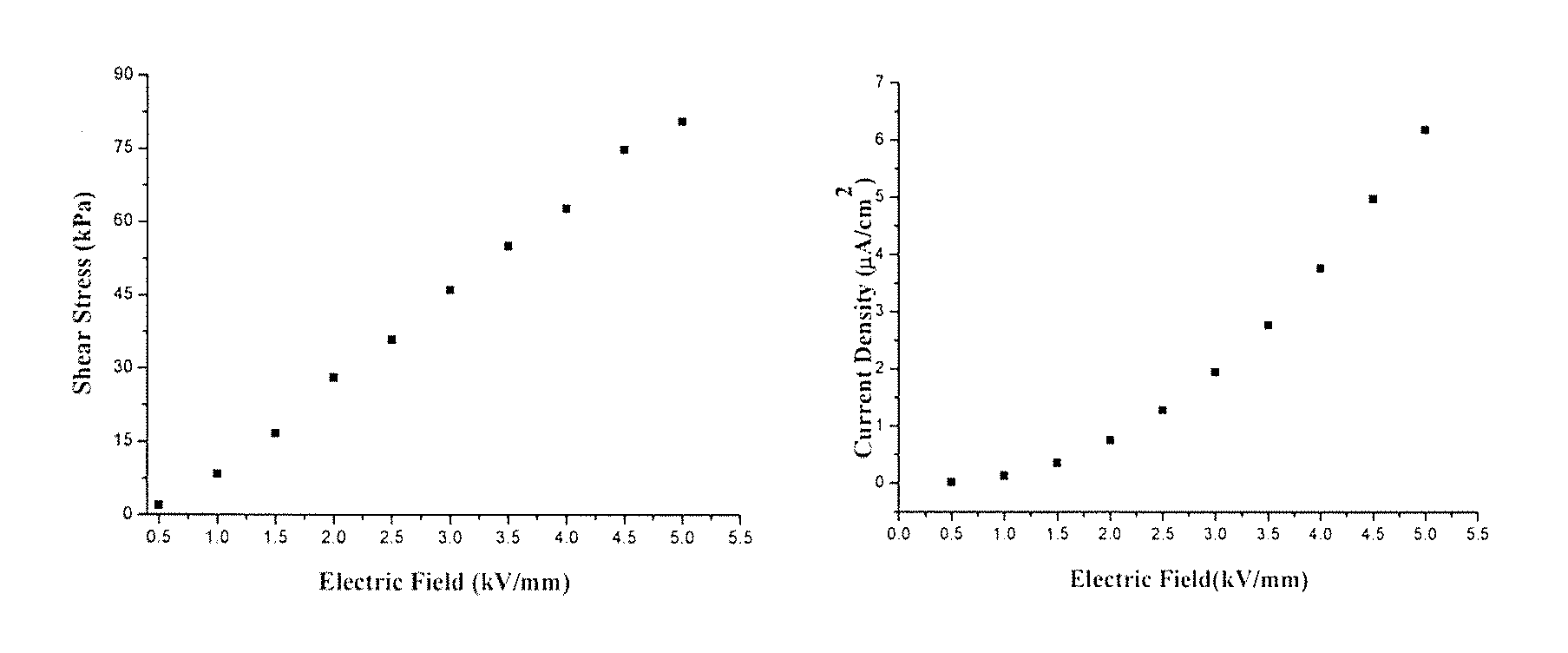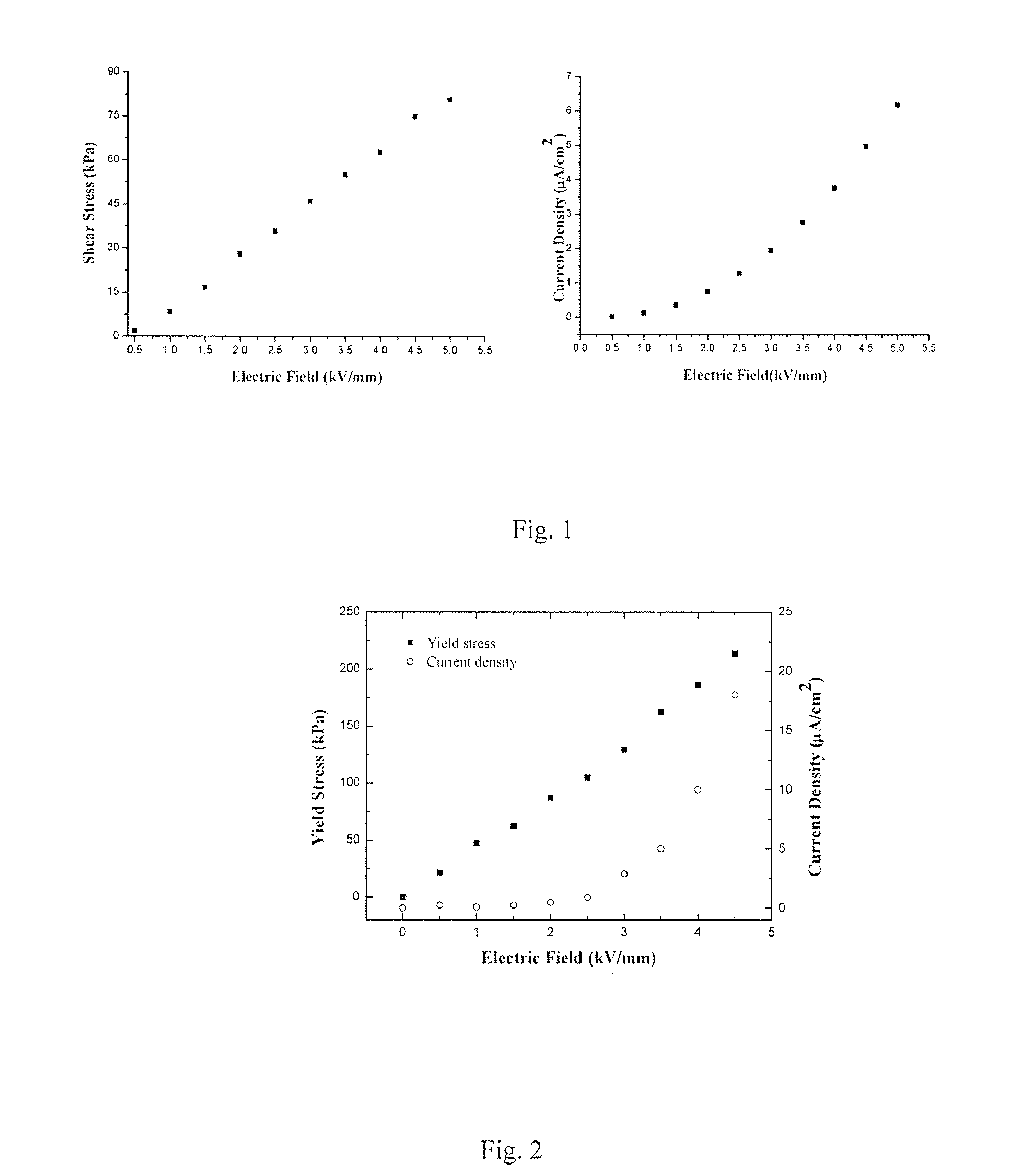Polar molecule dominated electrorheological fluid
a polar molecule and electrorheological fluid technology, applied in the direction of liquid organic insulators, metal/alloy conductors, conductors, etc., can solve the problems of lack of application, material has not been widely applied as expected, and cannot meet the requirements of technological and industrial applications
- Summary
- Abstract
- Description
- Claims
- Application Information
AI Technical Summary
Benefits of technology
Problems solved by technology
Method used
Image
Examples
example 1
[0031]The ER fluid of titanium oxide nanoparticles with the polar groups of C═O and C—NH2 are prepared by addition of acetamide. The dispersed phase contains the titanium oxide nanoparticles, and the dispersing medium is silicon oil. The titanium oxide particles are in spherical shape with diameter range of 50-100 nm and dielectric constant of 1000. The dipole moment of the polar group C═O and C—NH2 is 2.3-2.76 deb and 1.2-1.5 deb, respectively. The polar groups C═O and C—NH2, comprise 20 molar percent of the prepared titanium oxide nanoparticles.
[0032](1) Preparation of titanium oxide nanoparticles with polar groups C═O and C—NH2 via doping acetamide
[0033]The particles are prepared by the sol-gel method:
[0034]Composition 1: 30 ml Ti(OC4H9)4 is dissolved in 210 ml dehydrated ethanol, and the PH value is adjusted to 1-3 by hydrochloric acid solution. Composition 2: 40 ml deionized water and 150 ml dehydrated ethanol are homogeneously mixed.
[0035]Composition 3: 30 g acetamide is disso...
example 2
[0038]The ER fluid of titanium oxide nanoparticles with the polar groups of C═O and C—NH2 are prepared by doping of urea. The dispersed phase contains the titanium oxide nanoparticles, and the dispersing medium is silicon oil. FIG. 10 shows the scanning EM photo of the prepared titanium oxide nanoparticles, which are in spherical shape with an average diameter of 50 nm and dielectric constant of about 500. The dipole moment of the polar groups C═O and C—NH2 is 2.3-2.76 deb and 1.2-1.5 deb, respectively. The polar groups C═O and C—NH2 comprise 15 molar percent of the prepared titanium oxide nanoparticles.
[0039](1) Preparation of titanium oxide nanoparticles with polar groups C═O and C—NH2 via doping urea.
[0040]The particles are prepared by the sol-gel method:
[0041]Composition 1: 30 ml Ti(OC4H9)4 is dissolved in 150 ml dehydrated ethanol, and the PH value is adjusted by hydrochloric acid solution.
[0042]Composition 2: 40 ml deionized water is dissolved in 250 ml dehydrated ethanol, and...
example 3
[0046]The ER fluid of titanium oxide nanoparticles with the polar groups of O—H and C═O have a dispersed phase of titanium oxide and a dispersing medium of silicon oil. The polar groups are retained during the preparation of the titanium oxide nanoparticles. The titanium oxide nanoparticles are spherical in shape with an average diameter of 50 nm and dielectric number of about 500. The dipole moment of the polar groups O—H and C═O is 1.51 deb and 2.3-2.76 deb, respectively. The polar groups O—H and C═O comprise 5 molar percent of the nanoparticles.
[0047]First, tetra-n-butyl titanate is used as the starting material, water as the reacting reagent, and dehydrated ethanol as the solvent. With strong stirring, ethanol solution of water is added dropwise into dehydrated ethanol solution of tetra-u-butyl titanate, and the mixture is stirred continuously to form a gel. The gel is aged for several days and vacuum dried to white powder. After many washings, centrifugation, and filtering, the...
PUM
| Property | Measurement | Unit |
|---|---|---|
| size | aaaaa | aaaaa |
| dielectric constant | aaaaa | aaaaa |
| volume fraction | aaaaa | aaaaa |
Abstract
Description
Claims
Application Information
 Login to View More
Login to View More - R&D
- Intellectual Property
- Life Sciences
- Materials
- Tech Scout
- Unparalleled Data Quality
- Higher Quality Content
- 60% Fewer Hallucinations
Browse by: Latest US Patents, China's latest patents, Technical Efficacy Thesaurus, Application Domain, Technology Topic, Popular Technical Reports.
© 2025 PatSnap. All rights reserved.Legal|Privacy policy|Modern Slavery Act Transparency Statement|Sitemap|About US| Contact US: help@patsnap.com



